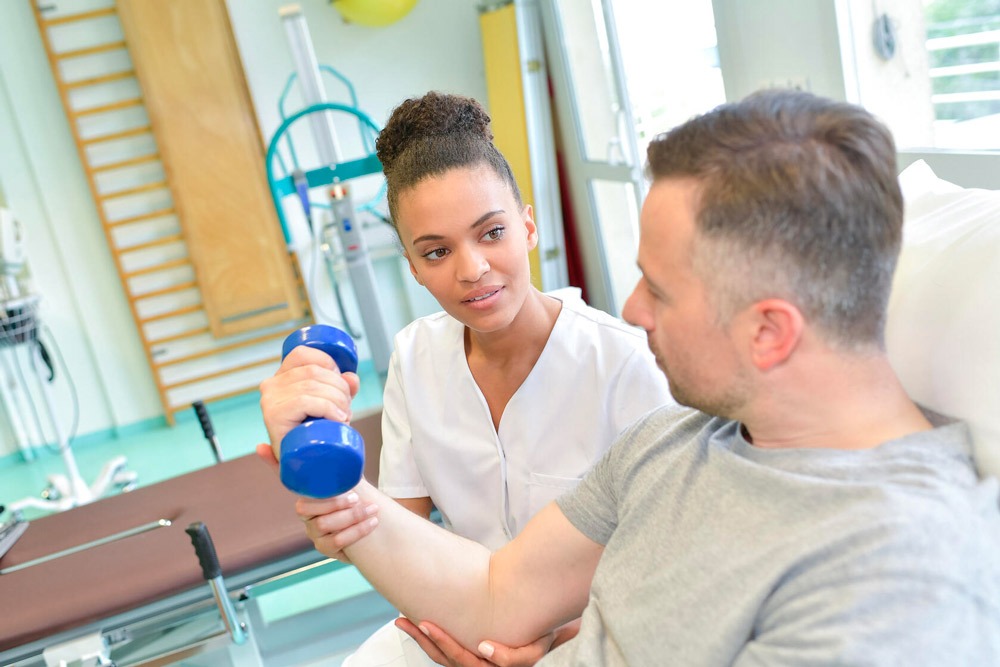
Strokes are sudden and often life-changing emergency medical situations that require immediate attention. Quick treatment can minimize the long-term impacts of strokes, which can become debilitating or life-threatening. Complications during the first three days following a stroke are common, necessitating medical teams to work quickly to stabilize a patient’s condition and prevent further worsening of symptoms or the possibility of new strokes.
What is a Stroke?
In short, a stroke is an attack on the brain that occurs when the blood supply suddenly is reduced or even cut off. A stroke can occur when an artery carrying blood with oxygen and nutrients to the brain is either blocked by a clot or ruptures. When this happens, the brain cannot get enough oxygen, causing some brain cells to die and produce disabilities that often occur after this medical event. There are two main types of strokes: ischemic and intercerebral hemorrhage. A third type, a transient ischemic attack (TIA) or mini-stroke, is caused by a temporary clot. TIAs also require immediate medical attention as they are frequent warnings that a more severe stroke is about to occur.
Ischemic Stroke
Approximately 85% of all strokes are ischemic. As blockages produce ischemic strokes, your medical team will work quickly to dissolve the clot and restore blood flow to the brain. According to Tufts Medical Center, one of the standard treatments that patients often receive in the hours following an ischemic stroke is IV tPA (intravenous tissue plasminogen activator), an FDA-approved medication that helps break up clots. Treatment with this medication can reduce the possibility of long-term stroke disabilities.
Patients who experience a large artery blockage may receive a catheter-based treatment called mechanical thrombectomy, a minimally invasive procedure that threads a wire into the neck arteries, entraps the clot, and removes it. Other treatments involve antiplatelet medications such as aspirin and Plavix to help reduce additional clot formation along with a strong blood thinner. Some patients also receive intravenous fluids to increase the bloodstream volume to minimize the heart’s work to pump blood to the brain. Blood pressure is also often allowed to remain higher for a short period to help restore blood flow and minimize further complications.
Victims of ischemic stroke are also temporarily more prone to developing blood clots in other parts of their bodies such as the legs, pelvis, and lungs, so doctors often require them to wear sequential compression devices that periodically squeeze the legs and get heparin injections under the skin.
Intracerebral Hemorrhage
These strokes occur when a weakened blood vessel ruptures and blood spills into the brain tissue. Three factors that exacerbate brain bleeding are uncontrolled high blood pressure, abnormal blood vessels, and an increased tendency to bleed. Therapies focus on stopping the bleeding as soon as possible. Patients with extremely high blood pressure will immediately begin medications to lower it. Treatments for patients who bleed easily include administering several different types of purified blood products such as fresh frozen plasma or medications like vitamin K. Blood vessel abnormalities may be treated through minimally invasive surgeries involving wire catheters. For extreme cases that involve life-threatening bleeding, a neurosurgeon may be called in to temporarily remove part of the skull to relieve pressure on the brain.
What Causes a Stroke?

Strokes occur through a combination of hereditary and lifestyle factors. They generally occur in people older than age 65, but anyone can have them, including children and babies. The risk factors for stroke are generally the same as those for heart disease. While you can’t control age and heredity, treating co-morbid conditions such as heart disease, high blood pressure, high cholesterol, and diabetes can help reduce the chances of suffering a stroke. Other factors contributing to stroke include:
-
Tobacco use
-
Alcohol abuse
-
Poor diet
-
Physical inactivity
-
Obesity
In addition to these overall risk factors, women have several unique factors that increase their chances of having a stroke. These include:
-
Pregnancy
-
History of preeclampsia
-
Oral contraceptive use
-
Post-menopausal hormone use
-
Migraine headaches with aura
What are the Signs of a Stroke?

Recognize the basic signs of a stroke through the acronym FAST, which means face drooping, arm weakness, speech difficulty, time t call 911. Other sudden signs that indicate a possible stroke are:
-
Numbness or weakness of the face, arm, or leg
-
Confusion or trouble understanding
-
Vision problems in one or both eyes
-
Difficulty walking, loss of balance or coordination, or dizziness
-
Severe headache with no known cause
Other Hospital Procedures Stroke Patients May Encounter
Most acute care of stroke patients takes place in a hospital unit devoted to the care of stroke and cardiac patients. Once your situation has stabilized, you can expect to receive a brain scan, usually within 12 hours of admittance to determine the cause of the stroke and its location in the brain. These scans will also ensure that you receive the right emergency treatment.
A CT (computed tomography) scan is an X-ray of the brain that will show the type of stroke that occurred as well as its location. Some patients also receive an MRI (magnetic resonance imaging), which shows the overall health and structure of blood vessels in the brain.
Your doctor may order additional tests involving your cardiovascular health to determine causes that may have contributed to your stroke. Possible tests include:
-
A carotid doppler to examine the rate of blood flow through the arteries in the front of your neck
-
An ECG (electrocardiogram) to record the rhythm and electrical activity of your heart to diagnose possible atrial fibrillation (AF), a type of irregular heartbeat the increases the risk of stroke
-
Blood tests to determine cholesterol levels, blood-clotting problems, or high sugar levels
Managing Early Stroke Complications
While still in the hospital, your medical team will closely evaluate you to ensure that the consequences of the stroke itself do not worsen but also for the development of side effects. Fever is a common side effect, sometimes due to infection or even the stroke itself. Many stroke patients feel extremely tired for several days, yet it is extremely important to begin moving as much as possible with the hospital staff’s help. Several additional complications can commonly arise during the first three days following a stroke.
Dysphagia and Aspiration of Food
Stroke patients sometimes lose their ability to swallow safely, leading to food and drink aspiration into the lungs. Aspiration can cause life-threatening injury to the lungs as well as an infection. Breathing problems can also develop, requiring respiratory support. Patients who have difficulty swallowing safely often require a temporary nasogastric tube threaded through one nostril to deliver good and flues until they can safely eat again. If this condition is expected to last for weeks or months, doctors may recommend the placement of a gastrostomy tube to provide nutrition directly to the stomach. Feeding tubes are generally temporary measures that are removed when patients can safely swallow.
Urinary Tract Infection
Sometimes patients require placement of a urinary catheter during their hospitalization. Urinary catheters can increase the risk for bladder infections, so they usually are removed as soon as possible. Such infections must also receive immediate treatment with antibiotics so the body can direct its healing efforts toward the brain.
Hyperglycemia
Blood sugar frequently rises when you are ill as you need the energy to fight illness. However, too much glucose in the system can worsen the effects of a stroke. Patients may receive small doses of insulin while in the hospital to keep blood sugar within an acceptable range even if they don’t have diabetes.
Deep Vein Thrombosis
Because the body tends to develop blood clots immediately following a stroke, medical teams will monitor patients to look for the possibility of deep vein thrombosis. Patients who are partially paralyzed are especially prone to this condition. Clots that form deep in the legs and pelvis can travel to the lungs and cause difficulty breathing. Medications for this condition must usually be delivered intravenously.
Brain Swelling
Severe strokes can damage a large portion of the brain and may result in swelling to tissue and damage to other areas of the brain not affected by the stroke. Such situations are life-threatening and require the care of a neurologist who will suggest a variety of treatments to help reduce swelling and minimize collateral damage.
Long-Term Effects and Stroke Recovery
Close monitoring of stroke patients in the first three days following the incident is crucial to evaluating and possibly reducing long-term effects. Stroke recovery time varies with each patient. Many require some type of therapy to restore function as much as possible to re-stroke levels. The type of long-term effects that patients experience depends on where in the brain the stroke occurred along with its severity.
Problems emanating from a stroke on the right side of the brain are:
-
Vision difficulties
-
Weakness or paralysis on the left side
-
Overconfidence and impulsive behavior
Problems resulting from left-side brain strokes are:
-
Speech and language difficulties
-
Right-side weakness and paralysis
-
Slow behavior
Physical Problems Caused by Stroke
A variety of physical problems can manifest following a stroke. Shoulder/hand syndrome can occur when the loss of muscle tone causes the shoulder to detach from its socket. Another phenomenon that frequently occurs is learned non-use. This condition occurs in some individuals when they accept the loss of function and only use the “good side” of the body. Spasticity is another problem. The neck, legs, and arms can change position and become stiff, painful, and shorten, resulting in limited mobility and interfering with daily activities.
If you experience these problems, your doctor will order physical therapy and/or occupational therapy to help restore function as close to normal as possible. In some cases, your doctor may also prescribe medications to aid in the restoration of functionality.
Communication Problems
Communication problems are also common following a stroke and can involve speech difficulties, language disorders, cognitive-linguistic deficits, or even a combination of all three. Speech therapy administered by language pathologists can address these problems, along with the aforementioned swallowing problems that occur in some individuals.
How Centric Healthcare Can Help
The first three months following a stroke are crucial for recovery. After a short time in the hospital, stroke patients may go to a subacute rehab facility where they can recover more slowly or directly home for rehabilitation. Recovery for stroke patients occurs at different rates. Some can experience spontaneous recovery, while others take weeks, months, and even longer to resume their normal activities. When you go home, you don’t have to go it alone as Centric Healthcare can provide the help needed to return to a normal life.
Our company can provide you or your loved one with a variety of home health care services that include a variety of therapists, skilled nursing care, medication management, mental health, senior home care, and much more. We will work closely with your medical care team to ensure that you or your loved one will get appropriate care as well as increase or decrease services as appropriate. Centric Health Care is here to help and give you the quality of life that you deserve. Contact us for further information and for a complimentary consultation to determine your home health care needs.

